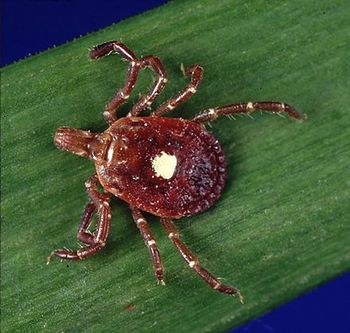
- May 2017
- Volume 2
- Issue 2
Tick-Borne Diseases Continue to Emerge and Increase in the United States
Experts explore how to develop and deliver effective prevention and treatment methods.
As the numbers of reported cases of tick-borne diseases (TBDs) continue to increase, so do the range of ticks that can carry these diseases, the amount of TBDs that have emerged, and the laboratory approaches to detect them, according to a panel of speakers in a March 21, 2017, webinar presented by the Centers for Disease Control and Prevention (CDC).
TBDs Are Expanding
According to Rebecca Eisen, PhD, from the CDC in Fort Collins, Colorado, despite the rise in infected individuals, just 3 ticks transmit most cases of reported TBDs in the United States: Ixodes scapularis (blacklegged tick), Amblyomma americanum (lone star tick), and Dermacentor variabilis (American dog tick).
“In recent decades, the numbers of many notifiable TBDs have steadily increased,” she said. “For example, the average number of reported Lyme disease cases has roughly tripled from 1992 to 2015. Likewise, the number of reported cases of anaplasmosis, ehrlichioses, and spotted fever group rickettsioses has steadily increased from 2000 to 2015.”
The geographic distribution of several TBDs is also expanding. From 1996 to 2015, the number of counties in which Ixodes scapularis was considered to be established more than doubled. Other factors also contribute to increases in the number of reported cases of TBDs and their distribution, she explained, including increasing human contact with ticks, landscape changes, a lack of effective prevention strategies, and improved diagnostics and clinical recognition.
No vaccines are available in the United States to prevent TBDs in humans. Current prevention strategies, such as personal protection measures, environmental modification, and tick suppression in animals, vary in efficacy and acceptability. “There is a need to develop effective approaches for preventing TBDs. But perhaps an even bigger challenge is how to deliver effective prevention strategies to large numbers of people and ultimately reduce the trend of increasing TBDs,” Dr. Eisen concluded.
Tick-Borne Spotted Fevers
The etiologic spectrum of tick-borne rickettsioses in the United States has expanded during the past 15 years, said Christopher D. Paddock, MD, from the CDC in Atlanta, Georgia. Rocky Mountain spotted fever (RMSF), caused by Rickettsia rickettsii, was the first recognized TBD in humans in the United States. The organism has a tropism for vascular endothelial cells, and the disease progresses rapidly to involve the skin, producing the characteristic maculopapular rash. Although RMSF can cause death when it involves the brain and lungs, Dr. Paddock stressed that doxycycline therapy has reduced the fatality rate to about 5%.
Most cases are reported from the central and southeastern United States, where Dermacentor variabilis is the main vector of the RMSF agent. However, Rhipicephalus sanguineus, the brown dog tick, more recently emerged as an unexpected vector of RMSF, noted Dr. Paddock. Epidemic levels of RMSF emerged in several American Indian communities in eastern Arizona between 2003 and 2012, with incidence rates approaching 150 times the national average.1 Large populations of these ticks have since expanded among free-roaming dogs in these communities. Fortunately, however, a 2-year pilot integrated tick prevention program was initiated in 2012 in one community with high rates of RMSF. This involved acaricide spraying of yards and placement of tick collars on more than 1000 dogs, and significantly reduced the number of ticks in this area and the number of cases of RMSF. Whereas about 51% of dogs in the community had visible tick infestations at the start of the tick control initiative in April 2012, fewer than 6% of dogs had visible infestations at the end of the project in September 2013.
RMSF was considered the only tick-borne rickettsiosis in the United States for more than 100 years, until Rickettsia parkeri emerged in 2004. This is transmitted by Amblyomma maculatum, the Gulf Coast tick, and also causes a skin rash. However, the R. parkeri rash is typically sparser than that in RMSF and may involve small vesicles or pustules. R. parkeri infection also produces a distinctive eschar, a small focus of necrotic skin, at the site of the tick bite. Eschars occur only rarely in RMSF, said Dr Paddock, and while RMSF is life-threatening, R. parkeri rickettsiosis is not.
The percentage of ticks infected with R. parkeri is also greater than the percentage of ticks infected with R. rickettsii of R. parkeri, said Dr. Paddock. About 1 in every 2 to 4 Gulf Coast ticks have been shown to be infected with R. parkeri. However, estimates suggest that fewer than 1 in 2000 ticks in the eastern United States harbor the bacteria, he added.
Emerging Tick-Borne Viruses
“Most of us think of TBDs as fairly badly neglected in the current environment, and tick-borne viruses are neglected even among these neglected pathogens,” said Gregory D. Ebel, ScD, from Colorado State University, Fort Collins. According to Dr. Ebel, Powassan virus (a flavivirus) is the tick-borne virus about which scientists know the most. It is maintained in nature in 3 distinct transmission cycles that involve woodchucks, squirrels, and deer ticks. Recent cases in humans seem to be related to the deer tick-driven transmission cycle, and this is partly why it is considered an emerging health threat in the United States.
Since 2006, 68 cases of Powassan encephalitis have been reported, said Dr. Ebel. Cases have occurred in the northeastern United States and upper Midwest, consistent with transmission by deer ticks. Severe disease occurs due to neurological involvement which arises secondary to either inflammation in the brain or direct neuronal injury, he noted.
First recognized in 2009 in Missouri, the Heartland virus, a phlebovirus transmitted by the bite of an infected lone star tick, is another emerging tick-borne virus, said Dr. Ebel. And one case of infection with Bourbon virus, a thogotovirus, was also reported in 2015. This virus remains poorly understood, but is probably tick-borne.2,3
Many knowledge gaps persist about how new tick-borne viruses emerge, and Dr. Ebel highlighted several factors that hinder tick-borne virus research. In particular, the tick’s long life cycle—which often exceeds the length of a research grant—is an extremely difficult barrier to overcome, he concluded. (Learn more about Powassan virus by reading, “Another Tick-Borne Disease Growing in the United States: Powassan Virus,” available at
Laboratory Detection Methods
Bobbi Pritt, MD, MSc, DTM&H, from Mayo Clinic in Rochester, Minnesota, discussed testing methods for diagnosing TBDs. Indirect methods measure the host’s immune response to an infecting organism, she said, and detect IgM or IgG class antibodies in serum. Serology is the method of choice for detecting many TBDs, but Dr. Pritt stressed that it is also insensitive in the first few days of an infection before antibody levels begin to rise. But by the second or third week, its sensitivity significantly increases, she said.
In contrast, direct methods detect the organism itself or some component of it. These include nuclei acid amplification tests, such as polymerase chain reaction to detect the organism’s DNA or RNA. Although nucleic acid amplification represents one of the earliest methods for detecting some organisms, it can be insensitive if nucleic acid is no longer detectable when the patient presents for evaluation. Nevertheless, it is especially useful for such organisms as the Ehrlichia species because large amounts of their DNA and RNA are present during the symptomatic stage of infection.
Several next-generation technologies are also emerging, said Dr. Pritt. Multiplex molecular panels can detect multiple bacterial, viral, and parasitic pathogens in a single test. In addition, broad range sequencing uses common targets and allows targeted gene amplification with subsequent sequence identification. “The last category of emerging technologies that I find particularly exciting is metagenomics,” she said, which allows amplification of all nucleic acid in a specimen, whether bacterial, fungal, viral, parasitic or human in origin. “This is currently very expensive and time consuming, but I think this is bound to change in the future,” she concluded.
Dr. Parry, a board-certified veterinary pathologist, graduated from the University of Liverpool in 1997. After 13 years in academia, she founded Midwest Veterinary Pathology, LLC, where she now works as a private consultant. Dr. Parry writes regularly for veterinary organizations and publications.
References:
- Drexler N, Miller M, Gerding J, et al. Community-based control of the brown dog tick in a region with high rates of Rocky Mountain spotted fever, 2012-2013. PLoS One. 2014;9(12):e112368.
- Centers for Disease Control and Prevention. Bourbon virus. CDC website. https://www.cdc.gov/ncezid/dvbd/bourbon/. Updated February 19, 2015. Accessed April 3, 2017.
- Kosoy OI, Lambert AJ, Hawkinson DJ, et al. Novel thogotovirus associated with febrile illness and death, United States, 2014. Emerg Infect Dis. 2015;21(5):760-764. doi: 10.3201/eid2105.150150.
Articles in this issue
over 7 years ago
A Cure for HIV? An Update One Year Laterover 8 years ago
Preventing Clostridium difficile From Getting Looseover 8 years ago
Changes in Therapy Guideline for Nosocomial PneumoniaNewsletter
Stay ahead of emerging infectious disease threats with expert insights and breaking research. Subscribe now to get updates delivered straight to your inbox.
















































































































































































































































































